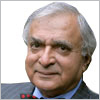China’s state sector has assumed the guise of Western corporations, but it is little more than a Party-run patronage system
First published at the Business Standard and posted here with the kind permission of the author.
 In my last column on China, I had noted how surprised I was on visiting that country after two years at its statist turn ("China’s hubris", Business Standard, June 18, 2011) . There is an ongoing debate in China between "liberals" and "conservatives" over whether the country should continue with the statist model or return to the more private sector-led model of the 1980s championed by Hu Yaobang and Zhao Ziyang. The liberals’ manifesto is outlined in a remarkable report titled China 2030, which was published in 2012 by the World Bank and Wen Jiabao’s Development Research Centre of the State Council. The collection of writings by Chinese authors on economic and foreign policy, titled China 3.0 (edited by Mark Leonard and published by the European Council on Foreign Relations, or ECFR, London, 2012), gives a flavour of the debate, which is elegantly summarised in Francois Godement’s essay, "China at the Crossroads" (ECFR, April 2012). But in order to understand how China – which seemed to be progressing to a full-fledged market economy under Zhu Rongji till 2003-05 – has come to this statist pass (the subject of this and my next column), it is important to see the unintended consequences of various measures taken by the reformers in the 1990s.
In my last column on China, I had noted how surprised I was on visiting that country after two years at its statist turn ("China’s hubris", Business Standard, June 18, 2011) . There is an ongoing debate in China between "liberals" and "conservatives" over whether the country should continue with the statist model or return to the more private sector-led model of the 1980s championed by Hu Yaobang and Zhao Ziyang. The liberals’ manifesto is outlined in a remarkable report titled China 2030, which was published in 2012 by the World Bank and Wen Jiabao’s Development Research Centre of the State Council. The collection of writings by Chinese authors on economic and foreign policy, titled China 3.0 (edited by Mark Leonard and published by the European Council on Foreign Relations, or ECFR, London, 2012), gives a flavour of the debate, which is elegantly summarised in Francois Godement’s essay, "China at the Crossroads" (ECFR, April 2012). But in order to understand how China – which seemed to be progressing to a full-fledged market economy under Zhu Rongji till 2003-05 – has come to this statist pass (the subject of this and my next column), it is important to see the unintended consequences of various measures taken by the reformers in the 1990s.
The first measure was to reform the inefficient loss-making state-owned enterprises, which had hung like an albatross around the neck of the Chinese economy, by using the rising value of the land they owned to finance their privatisation. The rise in land prices was the result of fierce local competition among the municipalities for foreign direct investment (FDI), which was leading China to become the workshop of the world (see my column "The mechanics of the Chinese miracle", October 29, 2008). With the help of revenue from land sales, all small and medium state-owned enterprises were privatised. The larger state-owned enterprises, which were deemed to be of strategic importance, were given monopolistic or oligopolistic rights – and, therefore, became profitable. Thus began the dual system: a non-state market economy and an increasingly state-led authoritarian capitalism in which the strategic industries controlled the commanding heights of the economy.
Mr Zhu also sought to transform state-owned banks into commercial banks by converting them into stock-holding banks and liberalising the interest rate, so that the stop-go cycles that had characterised China’s financial policy could be ended. Instead, as detailed in an important book by Carl E Walter and Fraser J T Howe, titled Red Capitalism, what has been created is an opaque system that has the trappings of a market system but not substance.
These trappings include a stock exchange, a bond market, purportedly commercial banks that are listed on global stock markets. The complex system marshals the massive savings of thrifty Chinese households to purposes determined by the interests of the "princelings" who increasingly control the party. Mr Godement notes that "there are many indications that China’s ‘princelings’ (the children of past leaders) have formed a quasi-union" due to "a 1992 decision inspired by Bo Yibo, a former close associate of Mao, that each leading ‘family’ would be able to promote one child into top politics". The list is now so large "it could fill a telephone directory". Thus, Mr Zhu’s effort to push the banks towards an international model has been derailed, and the banks have reverted to their traditional role in communist economies of being "huge deposit-taking institutions, extending loans as directed by their party leaders" (Red Capitalism).
 But how did China manage to create the facade of a market-based financial system? The opening step was Mr Zhu’s decision in early 1993, at the suggestion of the chief executive of Hong Kong’s stock exchange, to allow selected state-owned enterprises to list on Hong Kong’s stock exchange. He realised that this would require the restructuring of state-owned enterprises to conform to international legal, accounting and financial requirements, which he hoped would improve their management.
But how did China manage to create the facade of a market-based financial system? The opening step was Mr Zhu’s decision in early 1993, at the suggestion of the chief executive of Hong Kong’s stock exchange, to allow selected state-owned enterprises to list on Hong Kong’s stock exchange. He realised that this would require the restructuring of state-owned enterprises to conform to international legal, accounting and financial requirements, which he hoped would improve their management.
Enter Wall Street bankers and lawyers. The model was provided by the creation of China Mobile in 1997 by Goldman Sachs "out of a poorly managed assortment of provincial post and telecoms entities" and the package was then sold to international fund managers as a national telecommunications giant. Subsequently, China’s oil companies, banks and insurance companies, which raised billions through initial public offerings, "were imagined up, created and listed by American investment bankers". The government sought to have these companies listed on the Fortune Global 500 list, an aim Wall Street helped to achieve by 2009, with 44 of China’s "National Team" listed.
As a result, if the stock exchanges of Shanghai and Shenzen are combined with Hong Kong’s (dominated by Chinese companies), China has the second-largest equity capital in the world after New York, dwarfing those of Japan and India. From 1993 to early 2010, "Chinese state-owned enterprises have raised $389 billion on domestic exchanges and a further $262 billion on international markets, adding a total of $651 billion in capital to the $818 billion contributed by foreign direct investment".
These two sources of capital have had important political economy effects. The FDI flows created the private non-state economy, with transfer of technology and management techniques to Chinese entrepreneurs. The capital raised on domestic and international stock exchanges, by contrast, "has gone to creating and strengthening the companies ‘inside the system’ … the market capitalisation in Hong Kong, Shanghai and elsewhere belongs to companies controlled outright by China’s Communist Party: only minority stakes have been sold".
Thus, Professors Walter and Howe note that while China’s state sector has assumed the guise of Western corporations, this hides their true nature: that they are a patronage system centred on the Communist Party’s nomenklatura. "These companies are not autonomous corporations; they can hardly be said to be corporations at all. Their senior management and, indeed, the fate of the corporation itself are completely dependent on political patrons."
Whether the reformers will be able to win against this opposition of what the Wen Jiabao-sponsored China 2030 describes as "vested interests", and reverse China’s statist turn, remains an open question.
Deepak Lal is the James S. Coleman Professor Emeritus of International Development Studies at the University of California at Los Angeles, professor emeritus of political economy at University College London, and a senior fellow at the Cato Institute. He was a member of the Indian Foreign Service (1963-66) and has served as a consultant to the Indian Planning Commission, the World Bank, the Organization for Economic Cooperation and Development, various UN agencies, South Korea, and Sri Lanka. From 1984 to 1987 he was research administrator at the World Bank. Lal is the author of a number of books, including The Poverty of Development Economics; The Hindu Equilibrium; Against Dirigisme; The Political Economy of Poverty, Equity and Growth; Unintended Consequences: The Impact of Factor Endowments, Culture, and Politics on Long-Run Economic Performance; and Reviving the Invisible Hand: The Case for Classical Liberalism in the 21st Century.

